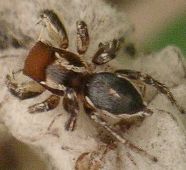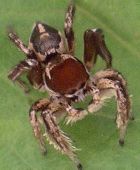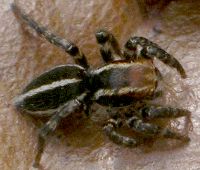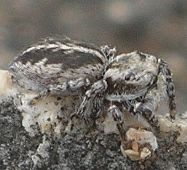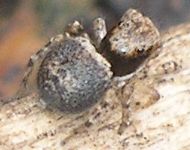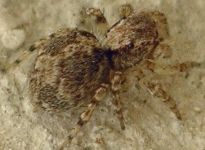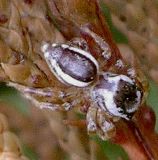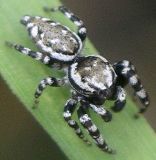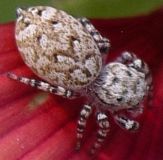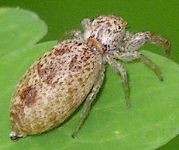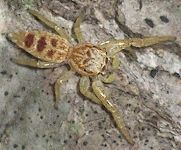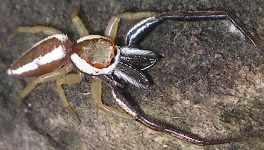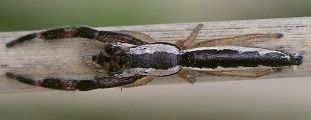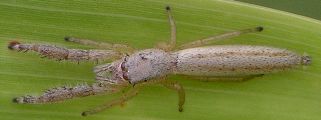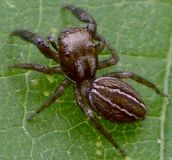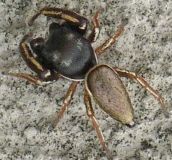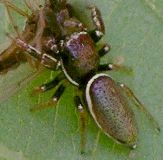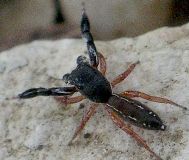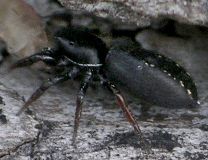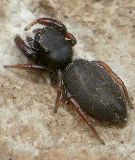
| Salticidae ~ Jumping Spiders |
|
One other Habronattus species that I've been able to identify is H. forticulus. This is another one for which I've only found males, but they are very distinctive in spite of their tiny size. The reddish section around the eyes shows quite clearly, as well as the general chocolate color with tan markings. However, the really cool thing about these is their brushy looking pedipalps, visible only if you get down on their level, which is not terribly easy as they tend to hang out on low-growing vegetation.
There is another jumper with a red "cap" and that is Phlegra hentzi. This spider is a bit larger than Habronattus species but is found in the same sort of habitat as some of those species: leaf litter. The black and white stripes are pretty consistent between individuals and the cephalothorax looks relatively long compared to many jumpers.
I'm not terribly certain about the identity of Pellenes limatus, but after eliminating other possibilities, it seems a good guess. The manner in which the legs are held and the size suggests Habronattus but this jumper is more flattened and longer in shape. The thick zigzag black lines down the abdomen seem to be good for identification. Another genus that can be confused with Habronattus is Naphrys. This one has recently had a name change. It used to be called Habrocestum. The diminutive Naphrys acerba is distinctly marked but only about 3 mm long. The dark part of the cephalothorax stands out, as does the light front of the bluish-gray abdomen. There are sometimes two light colored dots on the back of the abdomen, but these might not be very clearly marked, such as in the accompanying photo. This species is frequently found on the ground, especially on dirt under juniper trees, where they blend right in with the fallen bits of wood and other debris. Although a common species, this one is easily overlooked.
Naphrys pulex is another cryptically colored small species. It is a little bit larger than N. acerba and is usually found around structures with concrete or stonework. The light colored cephalothorax with dark sides and the markings on the abdomen are fairly distinctive and consistent. Another genus of very tiny spiders is Pelegrina. The male of one species that I find occasionally looks like a miniature version of the Bronze Jumper (Eris militaris) but is only about 4 mm long. This is Pelegrina pervaga and it is almost always found on juniper. It has white marks on the front of the cephalothorax that look like large eyebrows.
There is an easily identified species in the same genus, the Peppered Jumper (Pelegrina galathea). This is an extremely common spider, often found on flowers, which is unusual for jumping spiders. The only other species to regularly hunt around flowers is the huge Bold Jumper (Phidippus audax). This little spider, though, is a mere 4 mm long. The males have a complex pattern of black and white, but it is pretty consistent among individuals. Females are grayish, and also have the banded legs and complicated markings. They tend to have rather long abdomens.
Some jumping spiders are not the usual compact shape. One that is pretty elongate is Hentzia palmarum. Females of this species are tan with brown markings. They have thick front legs and a long abdomen. When they are extremely well fed or gravid, they look like they can hardly move about, let alone jump. The immature males of this species have similar coloration to the females, but they have distinct brown spots on their abdomen. Mature males are unlike any other species, with white bands on a brown body, three pairs of legs that are tan colored, and outrageous long front legs that are black. Their pedipalps are also incredibly long and black, with a fringe of white fuzz. These distinctive spiders are not large, at about 5 mm.
The most elongate species of jumper in our area is Marpissa pikei. Both males and females look like they have been stretched out and they are about 8-9 mm long. The males have black and white stripes while the females are very pale, and both have thickened front legs. They are usually found in tall grasses, where they hide quite easily. Marpissa lineata is not nearly as long as its cousin, M. pikei. It is smaller (around 5 mm in length) and its abdomen has thin white lines on a dark brown base, while the cephalothorax has a white smudgy area near the rear. It also has thick front legs.
Another jumping spider with thick front legs, and a long, slightly flattened appearance is Sassacus vitis. This one used to be called Metaphidippus vitis. Both males and females have dark cephalothoraxes with a white rim at the sides and metallic colored abdomens edged with white. The legs have white stripes. It's too bad that they are so small (around 4 mm long) that it is difficult to appreciate their pretty colors.
Yet another jumper with thick front legs is Metacyrba floridana. Males have thick black front legs but the rest of their legs are reddish. Body shape is rather flattened, with a completely black cephalothorax; the abdomen has two thin lines of broken light-colored dashes. This species is quite small and easily overlooked. A related species, Metacyrba taeniola is pretty common, usually found on the ground or under bark on fallen logs. It also hangs out on our back porch and sometimes ends up in the house. It is a bit more robust. The lines of dots on the abdomen may be very faint or even absent. |
![]()
